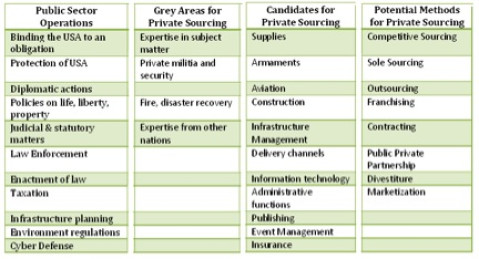Widgetized Section
Go to Admin » Appearance » Widgets » and move Gabfire Widget: Social into that MastheadOverlay zone
Outsourcing Government – A Strategic Approach to Partnered Privatization (Part 3)
The Next Era, Partnered-Privatization?
Fundamentally, the business of government is to enact law and develop policy with established measures to clearly demonstrate whether its policies are successful. The essential arms of the federal government include executive, legislative, defense and judiciary. The question is what functions should the administrative arm perform? And within that arm, which functions should the government perform and which should be carried out by its partners? Given the federalist model of the United States, many administrative functions have been devolved to local government, which has increased considerably in size in the past fifty years.
In examining functions performed by government, it may appear that social programs, for example, should be the purview of government. However, many state governments are turning over the management of many of these programs such as Medicaid to private organizations successfully. Welfare, food stamps and child care are being delivered through partnerships with community based organizations. Why not take this model to its ultimate realization? Why is it necessary to have shadow organizations in government in addition to external delivery channels when the work can be performed through memorandums of understanding, purchase-of-service agreements, franchising arrangements, subsidies, volunteer services and incentive programs?
 It would be instructive to develop a strategic plan for a state government and determine of the funds it appropriates and the federal subsidies it receives, what percentage is spent for administration and how much actually reaches the recipients of its programs. To take it a step further, if the policy department was required to only manage programs through third-party arrangements, what additional funds could be allocated to program recipients?
It would be instructive to develop a strategic plan for a state government and determine of the funds it appropriates and the federal subsidies it receives, what percentage is spent for administration and how much actually reaches the recipients of its programs. To take it a step further, if the policy department was required to only manage programs through third-party arrangements, what additional funds could be allocated to program recipients?
The agreement would be that in this transition of dramatically reducing government administration, public personnel would be hired on a merit basis by the private sector and job losses would be contained. Would this arrangement result in lower requirements for funds, and consequently taxation? In the study of the City of Indianapolis, efficiencies in cost and delivery were quantified and demonstrated. Consider those on a state and national level.
One might propose that such a model would result in the following results and benefits:
- Reduced Government
- Competitive “free market” process
- Higher levels of delivery
- Greater benefits to recipients
- Civil Service migrates to private sector
- Quality controlled by policy and measures
- Reduced costs through private sector innovation
- Lower taxation
- Robust economy
One thing is clear, the current methods of governing will not continue to function as change is outpacing outdated processes and thinking. The only constant in life is change, and change is coming much faster than our outdated approaches can deal with it.
Definition of Partnered-Privatization…Competitive Sourcing?
In August 1983, the Office of Management and Budget (OMB) issued circular No. A-76 entitled, “Performance of Commercial Activities,” thereby establishing federal policy for the performance of recurring commercial activities (CA). On May 29, 2003, OMB revised this circular in support of one of the major pillars of the Bush Administration’s promise of better management in government.
“Government should be market-based—we should not be afraid of competition, innovation, and choice. I will open government to the discipline of competition.” George W. Bush
There has been a tradition since 1955 where the government has relied on the private sector to provide needed commercial services (CA), whenever it was felt that it was proper and economical to do so. The program has grown to the point today where the engagement of the private sector for goods and services represents over sixty percent in terms of cost of government’s operations.
The President’s management agenda points out that increased competition consistently generates significant savings and noticeable performance improvements. For example:
CA’s are functions that provide products or services available from private sources. Governmental functions are those, which are not suitable for performance by private sources due to law or exercise of governmental discretion.
Recent competitions under OMB Circular A–76 have resulted in savings of more than 20 percent for work that stays in-house and more than 30 percent for work outsourced to the private sector.
From 1995 through 2000, the Department of Defense (DoD) completed more than 550 A-76 initiatives, which resulted in an average 34 percent reduction in cost. DoD expects to achieve $11.7 billion in savings as a result of A-76 competition between 1997 and 2005.
Numerous studies conducted by the General Accounting Office (GAO,) the Center for Naval Analyses, and others confirm the magnitude of these savings.
Competition promotes innovation, efficiency, and greater effectiveness. Citizens generally do not care whether the private or public sector provides the service or administers the program.
Goals of Partnered-Privatization
The goal of partnered-privatization should be the efficient and cost effective delivery of services without bias. That may mean the transfer of government services or assets to the private sector. State-owned assets may be sold to private owners, or statutory restrictions on competition between privately and publicly owned enterprises may be lifted. Services formerly provided by government may be contracted out. The objective is often to increase government efficiency without affecting services that it needs to provide to the public. A possible outcome might affect government revenue either positively or negatively. However, the eventual desire should be to reduce taxation in correlation to reduced government responsibility.
Public and private sectors have different objectives and goals. In as much as it is a trite statement, it is a true statement. Both sectors from a strategic planning perspective have missions, goals, objectives, stakeholders, goods, services, markets and customers. The difference is that public sector is a blend of a private sector model combined with a sense of philanthropy.
In many cities and towns, the government with its agencies, boards, commissions and affiliated organizations can be the mainstay and by far the largest employer. While that can attract certain types of businesses, the growth and wealth of a city is normally based on commercial business. Those businesses provide the majority of tax revenue. Government should be focused on economic development. Wearing that hat, it makes sense for agencies to separate government activities from commercial activities and to develop ways to grow the commercial sector.
From the table that was presented in an earlier section of this paper, it is evident that all levels of government from federal to municipal have grown significantly over the past two hundred years. The government is bloated. Federal, state and use taxes are up. It is not clear what value is being received from the expenditure of these funds to constituents. It is time to examine all government services and determine which are purely in the public domain, which have a huge commercial affinity and which are in a grey area. This must be performed holistically across all levels of government in an inclusive manner, led by the federal government. Otherwise and event still, states may claim the federal government is exceeding its mandate and interfering in the business of the states.
What this activity should result in is a categorized list as follows; some broad sample operations have been included:
Click to view the the first and second articles in this series.
_____________________________________________________________________
Shami Dugal is a member of ASPA and on the SHHSA Board. He has Bachelor’s degree in Operations Research from University of Waterloo (Canada) and an MPA from Drake University (Des Moines, Iowa). He can be reached at [email protected].
Image courtesy of http://www.against-the-grain.com/2012/07/news-announcements-71912/.







Robert L. Morrison
December 7, 2012 at 4:41 pm
Very well stated. The main objective comes down to can the community based organization operate in a less bureaucratic mode with the same or greater services being rendered at the same or lower costs.
It is also critical that once the change is made to insure the goals are met with both quantitative and non quantitative milestones.
If you have the same or less services being offered the government could be made to look foolish and lose credibility.
Efficency and a positive return on investment need to be expected and required.